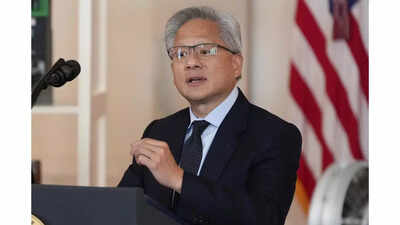Nvidia, the world’s leading producer of graphics processing units (GPUs) and a dominant force in the artificial intelligence (AI) industry, is facing a critical challenge as US-China trade tensions continue to escalate. CEO Jensen Huang recently emphasized the significance of the Chinese AI market, which he estimates could reach $50 billion in the next two to three years.
Speaking at ServiceNow’s Knowledge 2025 conference in Las Vegas, Huang described the potential loss of access to this market as a
"tremendous loss," highlighting the broader economic impact on US jobs, revenue, and technological leadership. This concern comes amid tighter US export restrictions that have significantly affected Nvidia’s business prospects in China, one of its largest international markets.
Nvidia targets $50 billion in China's AI boom – why it can't afford to miss out
China has long been a vital market for Nvidia, not only as a major consumer of its advanced AI chips but also as a hub for cutting-edge AI research and development. Nvidia’s GPUs, known for their unmatched parallel processing capabilities, are essential for training and deploying sophisticated AI models, making them indispensable for industries ranging from autonomous vehicles to cloud computing.
Huang noted in his interview that China’s AI market could grow to $50 billion within the next two to three years, presenting a massive revenue opportunity. Given that Nvidia’s GPUs have become the backbone of the global AI industry, securing a share of this rapidly expanding market is critical for the company’s long-term growth.
Impact of US export restrictions on Nvidia
However, Nvidia’s ability to access this lucrative market has been increasingly constrained by US export controls aimed at limiting China’s technological advancements. Last month, the Trump administration further tightened these restrictions, requiring special licenses for Nvidia to ship its H20 chips to China. These chips, part of the Hopper architecture, were specifically designed to comply with earlier export regulations but are now caught in the latest wave of trade restrictions.
As a result, Nvidia announced a staggering $5.5 billion quarterly charge, reflecting the financial blow of losing a critical revenue stream. This move marks one of the most significant financial impacts on the company since it became a trillion-dollar tech giant, raising concerns about the sustainability of its rapid growth.
Broader economic implications for the US
Huang highlighted the broader economic consequences of these export restrictions, emphasizing the potential loss of US jobs and tax revenue. During the interview, he argued that maintaining access to the Chinese market is not just about Nvidia’s bottom line but also about the long-term competitiveness of the US tech sector.
“We just have to stay agile,” Huang said, stressing the importance of balancing national security concerns with the need for economic growth and technological leadership. He added that the ongoing restrictions could force Chinese companies to develop domestic alternatives, potentially reducing US influence in the global AI industry over the long term.
China’s rapid AI advancements and competitive threats
Huang’s comments come amid growing concerns about China’s rapid progress in AI technology. At a separate tech conference in Washington, D.C., in April, Huang warned that China is “not behind” in AI and described Huawei as “one of the most formidable technology companies in the world.”
This assessment aligns with recent reports indicating that Chinese firms like Huawei and DeepSeek have made significant strides in developing their own AI chips, potentially challenging Nvidia’s dominance in this critical sector. Huang’s remarks underscore the competitive pressure Nvidia faces as it navigates a complex geopolitical landscape.
Financial performance and market outlook
Despite these challenges, Nvidia remains a dominant force in the global AI market. The company’s market capitalization has approached $3 trillion, making it one of the most valuable tech companies in the world. However, its stock has experienced significant volatility in recent months, with shares down about 15% so far this year after nearly tripling in 2023.
Nvidia is set to report its next quarterly earnings on May 28, with analysts expecting a 65% year-over-year revenue increase to $43.1 billion, according to data from LSEG. This projected growth reflects the ongoing demand for AI hardware, even as the company grapples with geopolitical uncertainties and supply chain challenges.
The path forward: Balancing growth and national security
Huang’s recent comments highlight the delicate balance Nvidia must strike as it seeks to maintain its leadership in the AI industry while navigating complex geopolitical challenges. As US policymakers weigh the risks and benefits of restricting high-tech exports to China, companies like Nvidia face tough decisions about how to adapt to an increasingly fragmented global market.
“The world is right now hungry, anxious to engage AI,” Huang said during his Las Vegas appearance.
“Let us get the American AI out in front of everybody right now.”With AI becoming a critical driver of economic growth and technological innovation, the stakes for Nvidia and the broader US tech sector have never been higher.









